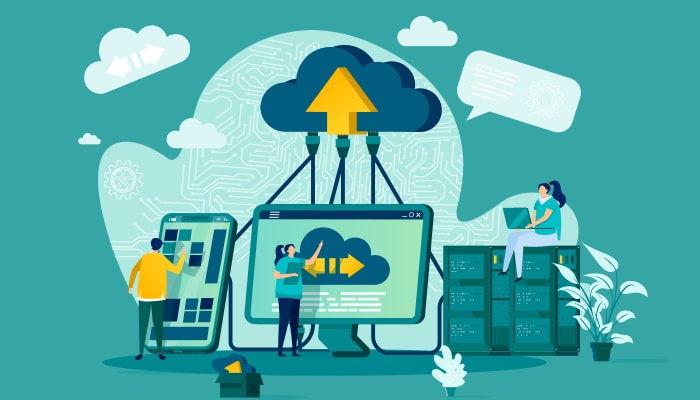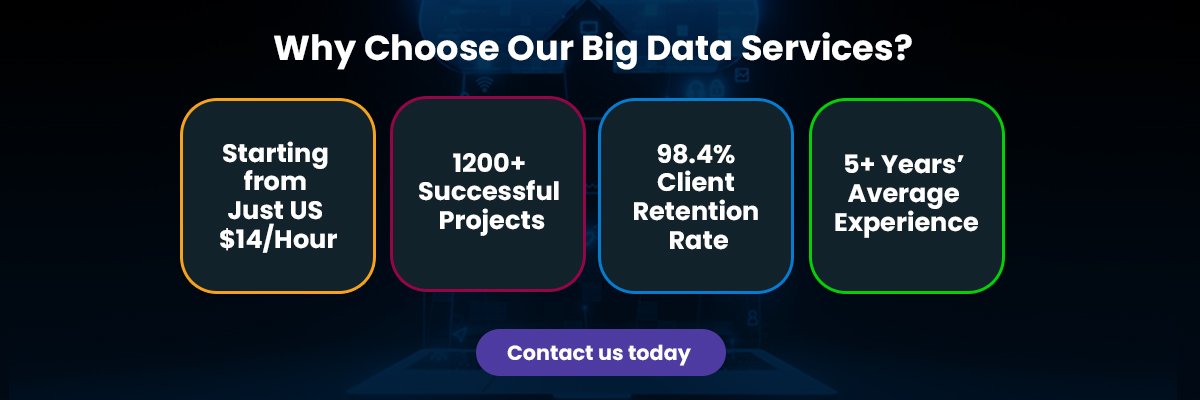Introduction
In a world of innovation, two game-changers, cloud computing, and big data, have taken the stage. Think of them as the dynamic duo reshaping the landscape of IT and business. Big data analytics in cloud computing is not just a tech evolution, it’s a revolution that’s made starting an IT company as easy as a walk in the digital park.
Think of these two as partners in a tech adventure, where cloud computing and big data analytics team up to transform your business dreams. Whether you’re a visionary with a stellar idea but limited resources or a corporate giant dealing with massive datasets – this alliance opens doors to extraordinary possibilities.
What is Cloud Computing?
Consider cloud computing as your digital assistant. It’s like having a magic online space where you store files, use servers, and run software without the hassle of managing them on your computer. Your files aren’t stuck and live on servers operated by a cloud service provider. And the best part? You can access them from anywhere with an internet connection.
There are different flavors of cloud services – think of them as various superpowers. There’s Infrastructure-as-a-Service (IaaS), Platform-as-a-Service (PaaS), and Software-as-a-Service (SaaS). Plus, you get to decide if your cloud is open to everyone (public), exclusive to you (private), or a mix of both (hybrid cloud). It’s like having a customizable digital playground at your fingertips.
Significance of Big Data Projects
Big data refers to significant, complex information that is challenging to handle using standard data management solutions.
Big data analytics involves examining large datasets to discover valuable insights, such as hidden patterns, correlations, market trends, and customer preferences. This analysis helps organizations make well-informed business decisions.
Looking at the bigger picture, data analytics technologies offer organizations a way to study datasets and gain new information. Business intelligence (BI) queries address fundamental questions about how businesses operate and perform.
The concept of big data and what it encompasses can be better understood with four Vs:
1.Volume: Big data involves a massive amount of information generated daily by private companies, public agencies, and various organizations.
2. Velocity: Data accumulates rapidly, but what’s crucial is how quickly we can process and analyze it to extract valuable insights.
3. Variety: The data collected comes in diverse types. There’s structured data found in databases, and then there’s unstructured data like tweets, emails, images, videos, and more. All of it needs to be consumed and processed.
4. Veracity: Due to big data’s vast scale and diversity, it often contains a lot of noise. Veracity is about the certainty of the data and how our tools and analysis strategies can distinguish between poor-quality data and information that truly matters to our business.
As we talk about big data, let’s see how it connects with cloud computing. Let’s talk about the role of cloud computing in big data.
The Intersection of Cloud Computing and Big Data
Cloud computing and big data are like partners in crime, and many cloud services do big data analytics. When you mix big data and cloud computing, even if you have a fantastic business idea but few resources, you still have a shot at business success. Big data analytics in cloud computing can bring extraordinary results for all sorts of organizations.
Companies use cloud service providers’ processing power, storage, networking, and other computing goodies to crunch big data numbers and keep their info systems running smoothly. Big data comes in all shapes and sizes, sometimes in a standard format. That’s where cloud computing steps in to save the day. It can take messy, non-standardized data and clean it up using artificial intelligence.
Imagine a world without cloud computing—handling big data would be a headache! Setting up the gear to store and process big data is expensive and takes time. Setting up and running a server could take weeks, even months. Thank goodness cloud computing makes things easier!
Now, let’s look at how big data and cloud computing work together and the advantages they bring-
Scalability
1. On-demand Resources:
Cloud computing helps organizations scale up their resources when needed. This is especially useful for Big Data projects where workloads vary. For example, during busy periods like monthly financial reporting, additional computing capacity can be quickly added without needing permanent infrastructure expansion.
2. Elasticity:
Elasticity in cloud computing is crucial for addressing the unpredictable nature of Big Data workloads. It allows resources to scale automatically based on changing demands, optimizing performance and resource use. Picture an online store during a busy event like Black Friday – the computing resources can quickly adapt to handle the surge in user activity and increased data processing requirements.
Cost Efficiency
1. Pay-as-you-go Model:
Cloud computing offers a pay-as-you-go model, allowing organizations to pay for the resources they use. This is beneficial for Big Data projects with unpredictable processing needs. For example, a research project can save costs by using only cloud resources during data analysis, paying for the actual computing time.
2. Reduced Infrastructure Costs:
Cloud computing changes the traditional approach of maintaining extensive on-premises infrastructure. It removes the need for large-scale investments and maintenance, reducing operational and capital expenses. This is especially useful for Big Data projects, as it meets storage and computational needs without the hassle of managing physical servers. It enables organizations to focus on innovation and data insights rather than dealing with hardware.
Flexibility
1. Different Services for Different Needs:
Cloud computing platforms provide various services that can be customized to fit specific needs. This is super useful for Big Data projects because they often have different requirements. Cloud services offer many options, whether storage space, computing power, or special tools for analyzing data. This flexibility lets organizations pick and choose what works best for their Big Data goals.
2. Multi-cloud and Hybrid Options:
Cloud computing isn’t a one-size-fits-all deal. Organizations can mix things up using different cloud services or combining public and private clouds. It’s like creating a customized solution that works for them. This is especially handy for Big Data projects that deal with sensitive info or need specific performance standards. Having this flexibility helps balance security, rules, and how things operate.
Breaking down the foundational elements contributing to the benefits of using cloud computing for Big Data projects:
Performance and Speed
a. High-Performance Computing (HPC):
Cloud computing platforms provide powerful computing capabilities crucial for analyzing Big Data. This helps process data-intensive tasks much faster, especially useful for complex algorithms and simulations.
b. Data Processing and Analysis:
The speed at which cloud platforms process and analyze data is a big plus for Big Data projects. Their scalable architecture enables efficient handling of vast datasets, leading to quicker decision-making.
c. Improved Time-to-Insight:
Cloud computing accelerates the journey from raw data to actionable insights. The on-demand nature of resources and high-performance computing reduces the time needed for data processing and analysis.
Data Security and Compliance
a. Robust Security Measures:
Cloud providers implement strong security measures like encryption and access controls to ensure data safety. This is crucial for Big Data projects dealing with sensitive information.
b. Compliance Standards:
Cloud platforms adhere to strict compliance standards (e.g., GDPR, HIPAA), simplifying regulatory compliance for Big Data projects. This assures organizations that their operations meet legal and industry-specific requirements.
Collaboration and Accessibility
a. Real-time Collaboration:
Cloud computing facilitates real-time collaboration among teams, even if they’re geographically dispersed. This is especially beneficial for Big Data projects involving cross-functional teams.
b. Remote Access to Resources:
Cloud resources are accessible from anywhere with an internet connection. This flexibility allows team members to work remotely on data, applications, and analytics tools, promoting a dynamic work environment.
c. Global Data Availability:
Cloud computing ensures the global availability of data, making it easy for organizations to distribute and access data from different locations. This is crucial for multinational corporations or projects with a broad reach, improving data redundancy and disaster recovery capabilities.
Why big data in the cloud makes perfect sense
Moving big data to the cloud makes a lot of sense for several reasons. Big data, which involves handling massive amounts of information quickly, requires strong software for storage and processing.
Cloud for big data ensures efficient data management, allowing access from any device. It also provides the necessary networking, storage, and computational power. Storing and processing large data volumes demand fault tolerance, scalability, and availability, all of which cloud computing delivers through hardware visualization.
In the cloud, handling petabytes of data becomes more accessible, enabling powerful analytics for business applications. The scalable environment of the cloud supports data-intensive applications. It also simplifies organizational connectivity and collaboration, granting more employees access to relevant analytics and making data sharing more efficient.
While IT leaders easily recognize the benefits, convincing executives about the advantages of combining big data with the cloud might be a challenge. However, this pairing offers executives a clearer business view and enhances data-driven decision-making. It is a good idea to hire big data engineers and let them handle all the hustle for you.
Conclusion
Cloud computing and big data analytics working together have changed how businesses do things. It’s like a key to exciting possibilities. Today, combining these two technologies is essential for companies not just to get by but to do well. The constant changes in big data and cloud computing show they’re all about trying new things and making good decisions.
Using this powerful combo helps businesses keep things simple and stay ahead in the business world that’s constantly changing. The partnership between cloud computing and big data isn’t just about tech, it’s a way to grow, be productive, and make starting and growing an IT company easier.








